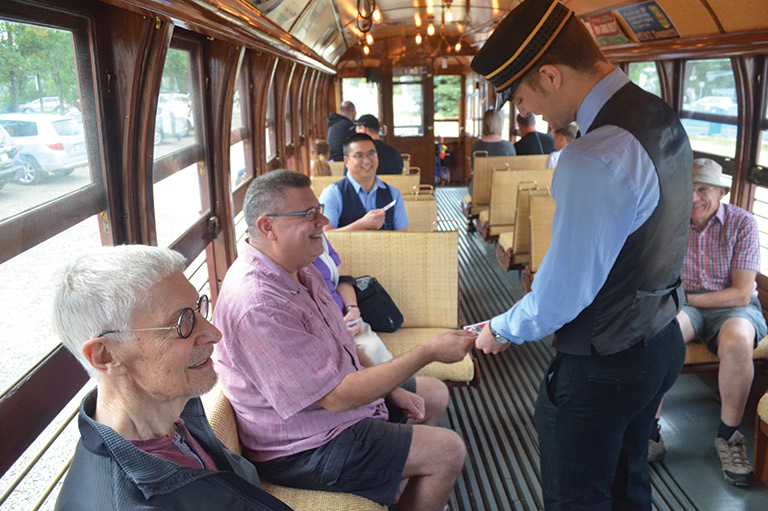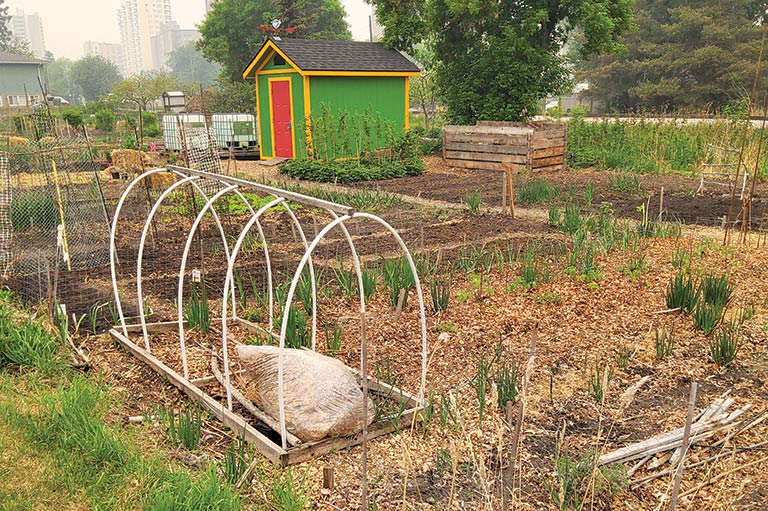Riding the Rails Through Edmonton’s History

Visiting the Old Strathcona community of south Edmonton is always a treat for me. I make a day of it, taking public transit there and back to avoid the headaches of traffic and parking. After disembarking at the corner of Whyte Avenue and 102nd Street, a forty-minute round trip historical guided tour awaits.
The Edmonton Radial Railway Society operates a one-hundred-per-cent volunteer-run historical streetcar tour along the remains of the old CPR line from the heart of Old Strathcona, over the North Saskatchewan River by way of the High Level Bridge, past the Alberta Legislature Building, and north to Jasper Plaza in the city centre.

Edmonton began its streetcar service in 1908, with an annual ridership of more than fourteen million passengers by 1929. The system wasn’t well maintained during the Great Depression, and in 1932 bus service began to replace some streetcar routes. But ridership jumped again during the busy years of the Second World War, and one streetcar was converted to become a mobile library.

The city’s transition to bus and trolley service was completed with a final ceremonial streetcar run across the bridge in September 1951. Then, in 1984, the railway society began its service with refurbished historical streetcars at Fort Edmonton Park, and by 1997 overhead lines had been installed on the High Level Bridge, allowing regular historical tours on that line as well.
I am so fond of riding the restored Edmonton streetcars that I always have a handful of tickets in my wallet. I buy them in packs of ten, because I never know when I might want a day to myself in Old Strathcona. Passengers are greeted by friendly volunteers dressed in white-and-black uniforms complete with smart-looking hats. You can either present your ticket or use cash to purchase a paper ticket that is then punched by the motorman — the term volunteers generally use to introduce themselves.
Upon boarding the streetcar, you’ll encounter the refreshing smell of polished wood, the high gloss of varnished wood panelling, and old-style sodium lighting. The exact experience will vary, as there are three types of cars in the fleet: Edmonton’s own streetcar number 33, dating back to 1912; Osaka number 247, manufactured in Japan in 1921; and Melbourne number 930, built in Australia in 1947.

Once everyone is seated, the streetcar takes off. One of the society’s volunteers drives the car, while another provides a summary history of the streetcar, the railway society, and various sites we pass — including the historic Strathcona Rail Community Garden.

There are six stops along the way from Whyte Avenue to Jasper Plaza, the northern terminus of the line, and some stops are made only by request. One of the highlights of the ride is going through the original CPR tunnel under 109th Street, which, the guide explains, is the longest CPR tunnel in Alberta.
The next and even more exciting part of the ride comes once you get to the High Level Bridge. Completed in 1913, the 110-year-old bridge is forty-eight metres above the river and 777 metres in length. The streetcar uses the old CPR track that runs above the automobile traffic level of the bridge. As the tour guide tells us, this used to be a three-track bridge, with freight trains in the middle and lines of streetcar track on either side.
The view from that far up is breathtaking. You can see the neighbouring light rail train bridge to one side — and, if you’re lucky, you may see a train go by while you’re high above, making it look like a small toy.

When the streetcar is once again on solid ground on the north side of the river, we pass the Alberta Legislature Building, then through another short tunnel under 100th Avenue, and continue to the Jasper Plaza stop. The ride back is much the same, but without the historical commentary.

Getting off the streetcar back in Old Strathcona, I wanted to enjoy some green space. Walking back about six blocks northwest of the Whyte Avenue terminus, I entered the Strathcona Rail Community Garden at 106th Street and 87th Avenue. Established as a veterans’ garden after the Second World War, it was redesignated as a community garden in the 1960s. Over the years the land the garden sits on has changed hands, eventually being purchased by the City of Edmonton, and sixty-five families can now grow food there. There’s a notoriously long waiting list to get a plot in the garden, because the land is very desirable and the location is ideal for growing.
The obligatory rhubarb and horseradish plants at the outskirts of the garden give way to the inner jewels of the space. As I stroll through the leafy green of the garden, I see orderly rows of peas, carrots, lettuces, herbs, and other veggies, with hills of potatoes and some harder-to-identify delights. Signage explains the purpose of the space and the rules of use.
After taking a break at one of the many restaurants and cafés on Whyte Avenue, a nice way to explore the area is by taking a “ghost tour” of Old Strathcona. Edmonton Ghost Tours are operated and hosted by Nadine Bailey, who recounts ghost sightings from within the community as she walks participants past historic places such as the Princess Theatre and the “pet cemetery” of Strathcona High School.
IF YOU GO

WHEN TO VISIT: The High Level Bridge Streetcar operates several days a week from the Victoria Day long weekend in May to the Thanksgiving long weekend in October. Find the schedule at edmontonstreetcars.ca.
GETTING THERE: Public transit buses number 4 or 8 will take you from the University of Alberta transit station to the Whyte Avenue streetcar terminal. There are some paid parking lots, but there’s limited street parking in the residential area around Whyte Avenue.
EXPLORE: A small museum in the Strathcona Streetcar Barn is open Saturdays during the same part of the year. The Old Strathcona Farmers’ Market operates Saturdays with dozens of vendors just off Whyte Avenue at 103rd Street, while the eclectic mix of shops on the avenue proper includes ethnic restaurants, comic book stores, a sourdough bakery, and more. The nearby Strathcona Library was completed in 1913 and was the first library in the city.
We hope you’ll help us continue to share fascinating stories about Canada’s past by making a donation to Canada’s History Society today.
We highlight our nation’s diverse past by telling stories that illuminate the people, places, and events that unite us as Canadians, and by making those stories accessible to everyone through our free online content.
We are a registered charity that depends on contributions from readers like you to share inspiring and informative stories with students and citizens of all ages — award-winning stories written by Canada’s top historians, authors, journalists, and history enthusiasts.
Any amount helps, or better yet, start a monthly donation today. Your support makes all the difference. Thank you!
Themes associated with this article
Advertisement
You might also like...
With 7 uniquely curated newsletters to choose from, we have something for everyone.
Save as much as 40% off the cover price! 4 issues per year as low as $29.95. Available in print and digital. Tariff-exempt!









